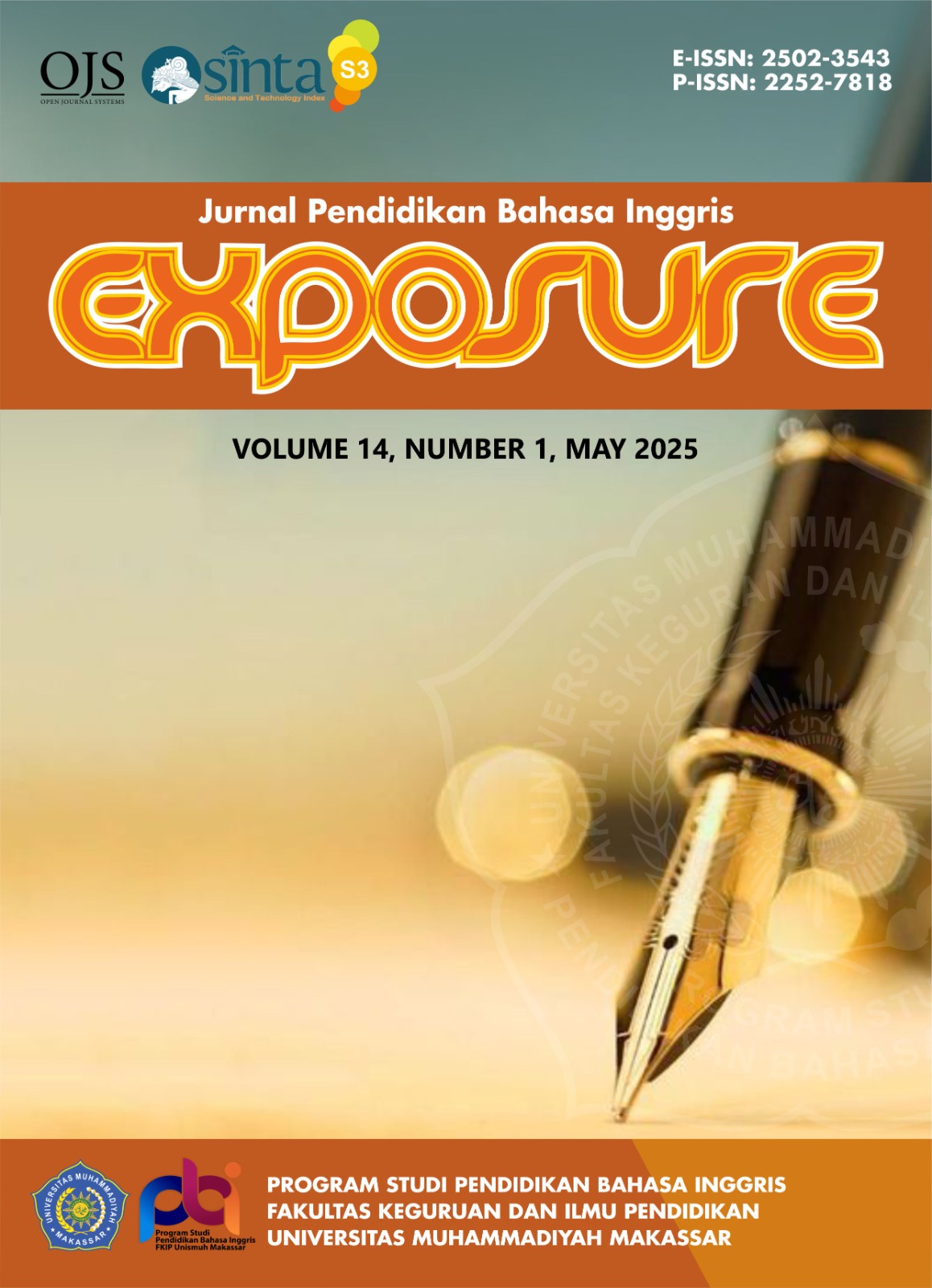INCREASING VOCABULARY SIZE OF GRADE VIII STUDENTS AT MTS MUHAMMADIYAH AL-HAQ PALU THROUGH SCAFFOLDING METHOD
DOI:
https://doi.org/10.26618/exposure.v14i1.14996Keywords:
Vocabulary, Scaffolding Method, IncreasingAbstract
Scaffolding is a teaching method in which teachers provide structured, temporary support to help students develop independent learning skills gradually. In the context of English as a Foreign Language (EFL), scaffolding is particularly useful in vocabulary acquisition, especially for young learners who are still building basic language skills. This study aims to find out the effectiveness of the scaffolding method in increasing students’ vocabulary size at MTs Muhammadiyah Al-Haq Palu. Students in grade VIII participated in this research. Two classes were identified as the control and experimental classes in this quasi-experimental research design. The researcher used a pretest and a posttest to collect data. Subsequently, SPSS version 23 was used to analyze the collected data. The result shows that the posttest mean score for students in the experimental class (78.22) was higher than the mean score in the control class (59.56). Furthermore, based on the result of the independence sample t-test, the sig (2 tailed) value (0.001) was lower than 0.05. It indicated that the alternative hypothesis was accepted. Therefore, the scaffolding method can increase the vocabulary size of grade VIII students at MTs Muhammadiyah Al-Haq Palu.
Downloads
References
Belland, B. R. (2017). Instructional Scaffolding in STEM Education. Springer International Publishing. https://doi.org/10.1007/978-3-319-02565-0
Brown, G. (2021). The Grammar of English Etymology: Essential Reading for Anyone Interested in the Evolution of English. Prabhat Prakashan.
Damanik, M., Malau, O. L., Sinaga, S., David, R., Siburian, & Simanjuntak, t. (2025). Implementasi Pendekatan Zone of Proximal Development (ZPD) dalam Mengatasi Kesulitan pada Materi Struktur Aljabar. As-Salam: Journal Islamic Social Sciences and Humanities, 3(1), 55-64.
Fisher, D., & Frey, N. (2008). Better Learning through Structured Teaching: A Framework for the Gradual Release of Responsibility. Virginia: ASCD.
Graves, M. F. (2016). The Vocabulary Book Learning and Instruction (Second Edition). New York: Teacher College Press.
Hasani, M., Mohseni, A., & Molai, B. (2024). Effect of Scaffolded Differentiation Strategies on Inferential Reading Comprehension and Receptive Vocabulary Improvement of Intermediate Students. 14(1), 191–211.
Kamil, R. (2017). Exploring Teacher’s Scaffolding to the Students in Teaching Writing. Journal of English and Education, 5(2), 187–193.
Krisnayanti, N. P. A., & Winarta, I. B. G. N. (2021). The Problems of Learning English Vocabulary in Harapan Senior High School. 2(22), 201–207.
Sari, I. P., Asahra, E. E., & Yana, Y. (2019). Improving Students’ Vocabulary Mastery Using English Songs. PROJECT (Professional Journal of English Education), 2(3), 410.
Suryani, I., Dewi, U., & Chuma, M. M. (2023). Scaffolding Strategies to Support English Language Learning in Reading Comprehension: A Case Study. Child Education Journal, 5(1), 24–35.
Susanto, A. (2017). The Teaching of Vocabulary: A Perspective. Jurnal KATA, 1(2), 182.
Wan, Y. (2022). The Application of Scaffolding Instruction to Vocabulary Teaching in Primary School. Journal of Higher Education Research, 3(2), 194.
Webb, S., & Nation, P. (2017). How Vocabulary is Learned. Oxford: Oxford University Press.
Xaydarovna, R. M. (2023). Instructional Scaffolding to Improve Learning.
Downloads
Published
Issue
Section
License
Authors who publish with this journal agree to the following terms:
In order to assure the highest standards for published articles, a peer review policy is applied. In pursue of the compliance with academic standards, all parties involved in the publishing process (the authors, the editors and the editorial board and the reviewers) agree to meet the responsibilities stated below in accordance to the Journal publication ethics and malpractice statement.
Duties of Authors:
- The author(s) warrant that the submitted article is an original work, which has not been previously published, and that they have obtained an agreement from any co-author(s) prior to the manuscript’s submission;
- The author(s) should not submit articles describing essentially the same research to more than one journal;
- The authors(s) make certain that the manuscript meets the terms of the Manuscript Submission Guideline regarding appropriate academic citation and that no copyright infringement occurs;
- The authors(s) should inform the editors about any conflict of interests and report any errors they subsequently, discover in their manuscript.
Duties of Editors and the Editorial Board:
- The editors, together with the editorial board, are responsible for deciding upon the publication or rejection of the submitted manuscripts based only on their originality, significance, and relevance to the domains of the journal;
- The editors evaluate the manuscripts compliance with academic criteria, the domains of the journal and the guidelines;
- The editors must at all times respect the confidentiality of any information pertaining to the submitted manuscripts;
- The editors assign the review of each manuscript to two reviewers chosen according to their domains of expertise. The editors must take into account any conflict of interest reported by the authors and the reviewers.
- The editors must ensure that the comments and recommendations of the reviewers are sent to the author(s) in due time and that the manuscripts are returned to the editors, who take the final decision to publish them or not.
Authors are permitted and encouraged to post online a pre-publication manuscript (but not the Publisher’s final formatted PDF version of the Work) in institutional repositories or on their Websites prior to and during the submission process, as it can lead to productive exchanges, as well as earlier and greater citation of published work (see The Effect of Open Access). Any such posting made before acceptance and publication of the Work shall be updated upon publication to include a reference to the Publisher-assigned DOI (Digital Object Identifier) and a link to the online abstract for the final published Work in the Journal.




